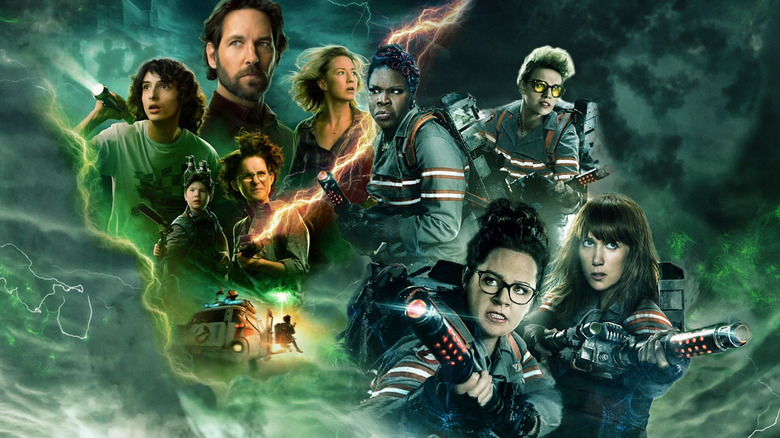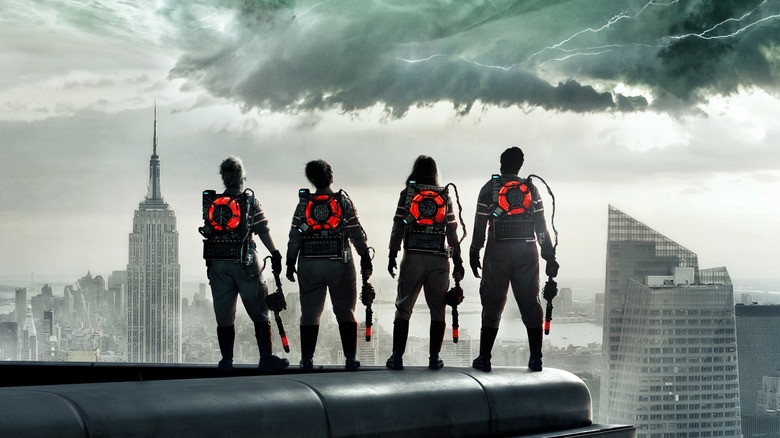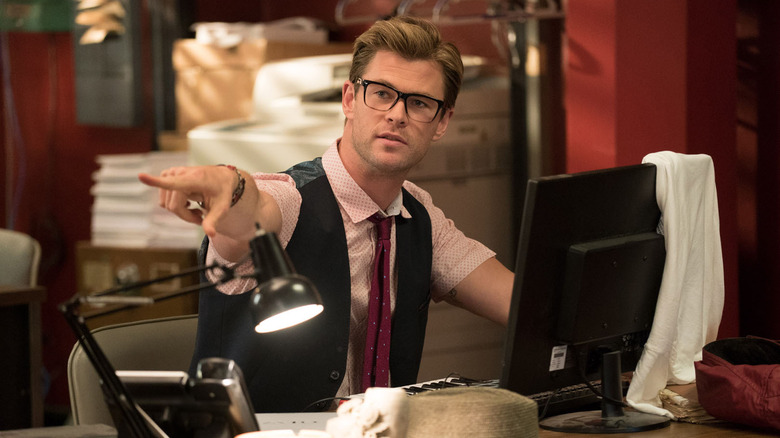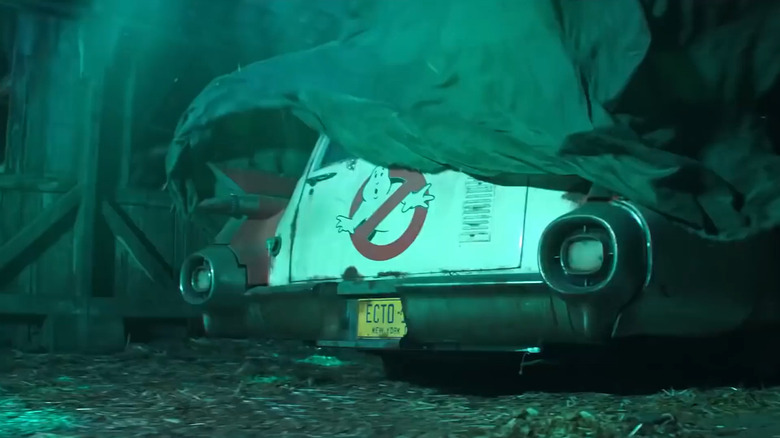Tales From The Box Office: Ghostbusters 2016 Oddly Paved The Way For Ghostbusters: Afterlife
In modern Hollywood, franchises don't stay dead for long. This weekend is proving as an illustration to that very point, as "Ghostbusters: Afterlife" is hitting theaters just five years after "Ghostbusters" (2016) failed quite spectacularly to reignite the long-dormant and beloved horror/comedy series. This new entry (which is more of a proper "Ghostbusters 3" in the way "Creed" was "Rocky VII") was originally supposed to come out last year, which would have been a wait of just four years between reboots.
With "Ghostbusters: Afterlife" now in theaters, we thought it would be a good time to have a look back at 2016's "Ghostbusters," where it went wrong (from a financial point of view), and how that ultimately paved the way for this new sequel to come about in a relatively short amount of time.
The Movie: Ghostbusters (2016)
"Ghostbusters II" came out in 1989, five years after the original went on to become a monster hit and an instant classic. But then the franchise went dormant for years, though it wasn't for a lack of trying. Bill Murray was reluctant to sign on for a third instalment following the relatively lackluster response to the sequel, while Dan Aykroyd, who co-wrote both of the original movies, plugged away trying to get another "Ghostbusters" movie made. In part thanks to the success of "Ghostbusters: The Video Game," a version of "Ghostbusters 3" written by Lee Eisenberg and Gene Stupnitsky ("The Office") came very close to happening around 2010/2011. However, it was once again Murray's artistic integrity that got in the way, with the actor explaining to GQ that he had script concerns and felt pressured to do the movie even though he didn't truly want to.
In the end, Murray's reluctance to sign on encouraged Columbia Pictures to pursue a reboot. Several ideas were floated, including a remake of the original, but things changed following the passing of Harold Ramis. Ivan Reitman opted not to direct and that paved the way for Paul Feig — coming hot off of "Bridesmaids" and "The Heat," not to mention his work on "The Office" — to fill in the director's chair. The big decision, however, came when it was decided that this would be a full-on reboot, not taking place within the continuity of the original films, and focusing on a female-led cast of Ghostbusters.
Ultimately, Kristen Wiig, Melissa McCarthy, Kate McKinnon, and Leslie Jones were selected as the four women who would lead the way, with Aykroyd, Murray, and Ernie Hudson signing on for cameos. And let us not forget Chris Hemsworth, Thor himself, who was cast as the Ghostbusters' trusty secretary. After years and years of development, filming kicked off in the summer of 2015, en route to a primetime summer release the following year. Unfortunately, this round of bustin' did not make the studio feel good.
The Financial Journey
"Ghostbusters" hit theaters on July 15, 2016, smack dab in the middle of the summer moviegoing season. Given that Sony ended up spending a truly massive $144 million on the movie (before marketing), it certainly fits the bill as a summer blockbuster, at least from an investment point of view. Unfortunately, it just didn't pan out in terms of moviegoer interest. Many fans reacted poorly to the trailers. Yes, there was unquestionably a toxic, highly vocal crowd that railed against the idea that it was women at the front of the franchise. That certainly didn't help matters any. The marketing, the tough sell of a reboot, a crowded summer release schedule, positive-but-not-glowing-reviews, a huge budget: it was a recipe for disaster.
"Ghostbusters" opened to $46 million domestically, which would have been more than fine for a modestly budgeted ghost picture, but this was "Avengers" money being spent. In the end, Feig's reboot pulled in $128.3 million domestically. Truth be told, on paper, that doesn't sound all that bad when we consider how much money modern blockbusters tend to make overseas. But that was the real issue here.
2016's "Ghostbusters" earned just $100.7 million overseas in total, making for a $229.1 million global haul. Even if we take the estimated $39 million or so in domestic home video sales, streaming, cable rights and, shall we say, cross those streams, it doesn't add up. Sony and its financial partners, particularly Village Roadshow, are said to have lost somewhere in the neighborhood of $75 million (per Variety), classifying this as a box office bomb. No two ways about it.
The Lessons Contained Within
In hindsight, there are many lessons to be taken away from 2016's "Ghostbusters." The decision to reboot the franchise instead of making a sequel, though it was made for seemingly understandable reasons, was not a good idea. I will never, ever go to bat for anyone being horrible online towards women or toxic fandoms. That having been said, it seems clear that (relative to the budget) not enough general moviegoers were interested in a "Ghostbusters" movie without anything to anchor it to what came before. I honestly think that even if it had been four guys in a similar reboot, the movie wouldn't have done much better.
"Ghostbusters: Afterlife" also largely hinges itself on female characters, particularly Mckenna Grace's Phoebe, who is the granddaughter of Egon. Not to spoil anything, but most of the movie focuses on new characters who are merely connected to the past iteration of the franchise, rather than on characters like Peter Venkman or Ray Stantz. Having those connections to the past really works for general audiences. Look at "Creed," "Star Wars: The Force Awakens," or "Jurassic World." The proof is out there.
Aside from that, the biggest lesson here is that not every movie needs to cost $150 million or more to make. Don't set your movie up to fail. This is something I've talked about a lot in other pieces, such as my look back at "Blade Runner: 2049," but inflating a movie's budget pushes the milestones for breaking even at the box office further and further away. Case in point, "Ghostbusters: Afterlife" had a production budget said to be in the $70 to $75 million range. If it makes $229 million worldwide, that would arguably be perfectly fine, especially by pandemic standards. Sony and director Jason Reitman gave this movie a real chance by keeping the budget in check.
Ultimately, the failure of the 2016 "Ghostbusters" reboot provided harsh lessons. The studio took those lessons to heart and made a modestly-budgeted sequel that paired new characters and a present-day story with strong connections to the original movie. Though "Ghostbusters: Afterlife" has made a slightly smaller splash at the box office in its opening weekend, currently set to gross an estimated $40.5 million compared to "Ghostbusters" (2016)'s $46 million debut, it's already a lot closer to its break-even point.



